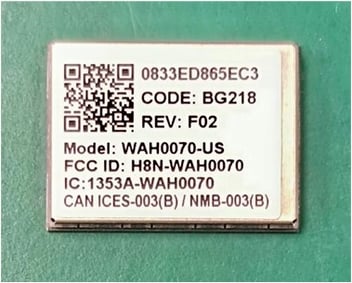Newracom’s Wi-Fi HaLow SoC solution to brMARKETidge connectivity gaps of mass- products
Author by Judy Lin | Digitimes, Taipei
Newracom, a US startup headquartered in Irvine, California, launched the world’s first Wi-Fi HaLow commercial sensor solution with IoT device provider Deviceworx last December, just one month after HaLow became Wi-Fi certified products incorporating IEEE 802.11ah technology.
DIGITIMES had an interview with Newracom’s CMO Hyun Seok Oh and VP of Global Sales and Marketing Frank Lin, to explore the potential and future outlook of Wi-Fi HaLow applications.
Wi-Fi HaLow is a lower-power, longer-range, and more robust version of Wi-Fi operating in the unlicensed sub-1-GHz spectrum. The new technology is ratified in 2016 to expand Wi-Fi applications for the Internet of Things (IoT). It has more range – about 1KM – and claims to provide a more robust connection in challenging environments due to its ability to penetrate walls or other barriers. It is also claimed to deliver low power, high performance, and more secure Wi-Fi for IoT-enabled devices.
Now with Wi-Fi Alliance’s introduction of Wi-Fi HaLow, signaling the opening of new opportunities for product and business model innovations based on the technology.
Q: Could you make a brief introduction about the background of Newracom and the size of the team?
Oh: Newracom was actually spun off from the Electronics and Telecommunication Research Institute of South Korea in 2014. It’s the whole Wi-Fi team under the ETRI, so to speak. We established the company seven years ago, with a vision of leading the IoT world with revolutionary wireless solutions.
We want to support the wireless solution providers in the IoT application area with cost-effective and efficient SoC solutions. And eventually, we are going to apply our solutions to AI-enabled applications too. Currently, we have 70 employees and will continue to expand the team.
We are headquartered in Irvine, California, also with a big research and development team in Seoul, South Korea.
Q: As Newracom produces Wi-Fi HaLow solution combined with SOC and what is the processing node that you need for your chips? Any impact to your business during the chip crunch?
Lin: basically, the SoC solution that we provide to the market is actually tailored to a more mature process, primarily utilizing the 40-millimeter process to develop our current generation products.
And luckily, our operation production team foresee some allocation in terms of capacity prior to the pandemic situation, so we were able to allocate sufficient supply to our initial customer’s deployment. We are still carefully monitoring the current supply situation.
Q: Recently people started to talk about Wi-Fi 7 is likely to replace Wi-Fi 6 very soon. We are curious what is the impact Wi-Fi 7 is going to have on Wi-Fi HaLow.
Lin: Wi-Fi 7 is a mass-market application for indoor infotainment connectivity. Wi-Fi HaLow architecture is primarily used to create different companion use cases and applications to accommodate standard Wi-Fi’s shortcomings. Since the Wi-Fi HaLow is also internet protocol (IP)-based, it can be seamlessly connected with standard Wi-Fi, and users don’t need to worry about signals dropping when they are on the move. That is a true value proposition our customers really appreciate.
Within the Asian region, there’s a lot of experience and knowledge about deploying Wi-Fi and use cases of standard Wi-Fi. Wi-Fi HaLow has its own different solution products, basically, catering to certain areas right now to expand to new use cases. IEEE sees that value proposition. So when they create this subcategory, 11ah, to accommodate this wide range of abilities, including movement and sufficient power consumption, it basically created a brand-new category without replacing or actually jeopardizing the mass-market standard.
Q: You mentioned the scenario of moving mobility, longer range, do you need to install in an open space for some use cases? What are the companies that you are collaborating with for various applications?
A: Basically, what they have done is very much like your traditional MVNO model, meaning that they have a self-sustained network, they can deploy very quickly. Anybody who has knowledge and experience in deploying mass-market Wi-Fi networks solutions is able to set up Wi-Fi HaLow infrastructure.
In scenarios such as deploying gateway and access points in 20, 30, or 50 convenience stores, they can actually base on 11ah technology to create a seamless local area network, let’s say, 5 or 10 kilometers range, you know, depending on a capacity of the devices you want to accommodate.
We have customers who are not your traditional mass-market carrier service provider, but they could actually, based on the user scenario and application develop, say, a retail facility. A single solution provider could actually deploy that including the service, including the back-end server and the cloud.
To provide this scenario, our customers can take full control of the management, including the device, the gateway, and export. And a lot of those customers much appreciate that because a lot of data collection and also cloud-based data collection, are in certain privacy walls, meaning the information they collect, a lot of time they used for AI analytics. And those are very valuable from a business perspective. And for them to be able to have a seamless connection and control that network, they don’t have to go through a third-party network, meaning that anything that they collect within their proximity, they can go straight to their server, up to the cloud, and do their own analysis to improve the productivity, improve the user experience and others.
Applications as such are very useful for industries such as retail, logistic, or factory automation facility, surveillance, and others. And those are kinds of add-on services or technology they can use, based on IEEE 802.11ah.
Q: Sounds very exciting, when people can, you know, adopt this application and use it in various scenarios. As we know, there are recently some smart manufacturing companies, I mean, networks using 5g or Open-RAN or LPWAN et-cetera, and what are the pros and cons of using them versus using Wi-Fi HaLow?
A: Under the scenario category, there is only a certain application that will fully utilize the capacity of 5G, autonomous driving is one. But not all applications will require 5G to the run-up. When you don’t use the full capacity of 5G to really benefit that, it becomes an over-spec issue and a burden, because the infrastructure investment, operational cost, and maintenance operation of 5G are very, very expensive. And the investment return of using the technology will be not justifiable, especially in low population density areas.
Here comes Wi-Fi HaLow to a very unique position. Since 11ah is still a local area network, and within a network, you still eventually have to go back to your mainstream backhaul. A combination with a local telco, such as Chunghwa, NTT, and others, to form a hybrid model would be feasible. The telcos will provide a certain 5G service and that service will become your centralized backhaul, and other solution providers can deploy the local area network accommodated by multiple 11ah access points.
We have seen customers rolling out products and services that combine cellular backhaul networks plus the local area network. It accommodates with this kind of TCP IP protocol without having to pay a high monthly 5G data rate and other accumulation of costs.
If you have 100% of a new category of application and the use cases, maybe 5G will accommodate 30% of that to run the new next-generation autonomous vehicle and others, there’s maybe another 40% or 50% of your mass-market Wi-Fi 6 or Wi-Fi 7, then they had this balance of 30% that will accommodate others including LPWAN players such as LoRa, ZigBee and others. And that will be a category that Wi-Fi HaLow can fully maximize its potential.
Q: And since there are also other Wi-Fi Halo competitors, how do you differentiate from them? And if the Wi-Fi giants start to join the HaLow market, how will Newracom respond to the competition?
A: With the performance and the technology itself, 11ah will constantly have an advantage compared to other competitors. At the same time, we are progressing to more of a solution approach. Looking at different adoption models in terms of usability, we are also monitoring how we’re able to present to our customers in complete solution approaches, specifically not just a wireless segment of technology. That will be a very good differentiation compared to say, incumbent of the larger company that will come into the market.
In terms of competition with other startups, we have the maturity in the combination of silicon and software. Since there’s a variety of scenarios that we deploy in certain regions or an area, there’s a local criterion of performance feature and others. And a lot of times those cannot be identified or duplicatable, inside the lab, you have to have regional, real scenario deployment to get those feedback. So what we have done is basically utilize those kinds of interactions with customers to really accelerate our overall SDK software performance and maturity. And that really helped us to cap the competition.
Our product straightforwardly embeds our software in the IC design to the foundry process. Customers get the hardware, but since this is a wireless connectivity product, it’s very dynamic, in terms of deployment, scenario, environment and others.
We are also very much deeply engaged with the open-source community, basically taking our open WRT SDK, to develop their catering application and product requirements. And obviously, you need hardware as a base platform to do that development. So under that scenario, we have a wide variety of range of customers that develop in different form factors, different hardware, different combinations of processors and others. That will actually help our customers, to really accelerate quickly time to market. So what we provide is ready to a turnkey solution. And we had done that very consistently the last few years to really help our customers do that.
And one other scenario is, obviously, compared to our upcoming competitors, we really tried to utilize the industry knowledge in the domain. Now more than 90% of the embedded developing communities are ARM-based, right? Meaning that they have a lot of knowledge experiences domain based on ARM core processes. And that’s how we roll out our technology to the market as well in all our development, environment, and experience. Our processing core is all based on the ARM environment.
Q: Wi-Fi HaLow sounds like a very scalable solution. What is your estimation for the market size of Wi-Fi HaLow?
A: What I can share is based on our actual customer input. For example, some of the tier-one ODMs or OEMs around the world come to us because they are not satisfied with their mass-market Wi-Fi products applications, and they want to use 11ah to improve their overall user experience. If you look at the global consumption of Wi-Fi, we see the possibility of adoption by at least 15-20% of the issuing customers to improve the overall user experience by overcoming mass-market product limitations. So we expect the global consumption of 11ah to be 15-20% of the Wi-Fi market.




